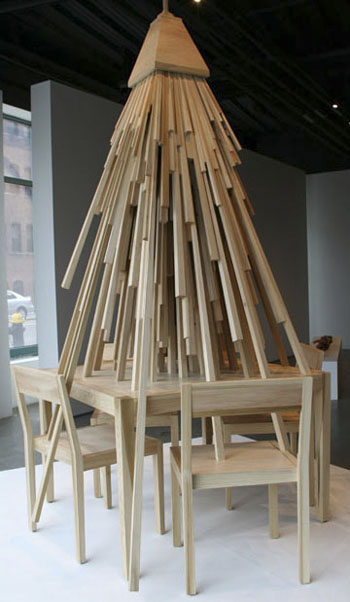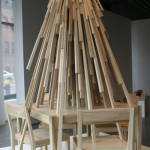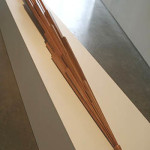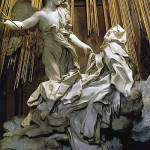By MATTHEW GAMBER
Imagine: a table set, a set of chairs, all beautifully crafted - a desirable set of furniture. However, the only interruption, transgressing one's desire for the object, are the large intersecting planks, symbolizing invisible light from a bare bulb, emitting from an also finely crafted lampshade above. This object has a familiar yet immediately foreign presence.
A table, a basic piece of home furnishing, is understood that its form is used to evoke shortcut analogies. Here it was, this table, made of wood, a familiar material noted in catalogs for its warmth, due to its rarity now that our world is mostly manufactured, and functional (on occasion).
Sometimes function does not follow from - metaphor follows form, and is the case with Darren Foote's sculptures. Initially, I wanted to couch my response to the sculptures in the logic of early twentieth century art. The furniture has the simplicity and the machined look of a Bauhaus mentor designing in a woodshop, rather than a foundry, and the implied motion of light and the illogic of incorporating it (overriding any functional utility), all nodded to the dynamism of Futurism and repulsive Dada objects.
Considering these collisions of modernist attributes, it appears as a clever l'art pour l'art assemblage of incongruent philosophies. However, In his artist statement, Foote writes that he:
“ . . . (is) interested in the barriers between material and emotion, tactility, and the ephemeral . . . I have always liked the notion that heaven is in the clouds above us and hell is deep and hot below. Literality can be ridiculous, sure, but it also has the ability to illuminate moments stuck in the collective consciousness."
Perhaps the most vital parts of these sculptures are irrational, and merely experiential. It can be said the art made in the flurry of isms are motivated and informed by this quality. While Foote's sculptures have some visual modernist precedents, he shares none of the same revolutionary motivations, except for one: transformation.
Foote is interested in the familiarity of domestic objects. Looking at the other pieces, the visual theme for the show is not the utility of furniture, or craftsmanship. Rather, it is the representation of mundane lighting fixtures (a flashlight, a basic gallery light can) as beautiful objects of historically unindustrialized material (poplar wood). But that's only part of it. The largest pieces of wood are reserved for the rays of light emitting from these fixtures. How does light project and what is the effect when it falls on objects? Why does lighting have such an emotive quality?
Comparing Foote's work to Bernini's sculpture, Ecstasy of St. Teresa, we can see the similar kind of presentation of light which is theatrical, symbolic, and decorative. The subject of St. Teresa is the dramatization of the event where the historical figure, a nun named Teresa of Avila, is erotically enraptured by an angel. Sexual connotations aside, the piece is supposed to represent the idea of transverberation or religious ecstasy, where one becomes the connection between the physical and spiritual manifestation. Outside of the church (being interested in archetypal, everyday forms), this idea can conforms to Foote's motivations as noted in his artist statement when, again, he says he interested in the "barriers between material and emotion".
Though, in St. Teresa, we see the object of the radiance, but in Foote's sculptures, the represented light is seemingly dislocated. We are left to imagine what we illuminate. What does this modeled light radiate? Rather simplified, light falling on surface is reflected and we see it. As is the hope of many photographers, one of the presumed goals is to render objects ordinary as extraordinarily, capturing the particular qualities of light off of those surfaces. The transformative ability, in some photographs and in Foote's sculpture, develops as a change of common recognition. Though, since these sculptures are the objects, we see the light illuminate sculpted representations of light rays. The logic of needing light to create these sculptures whose subject is controlled lighting is almost recursive, perhaps as humorous as the everyday totems, slipping into metaphor.
- Darren Foote, Dining Table, Poplar, 2008.
- Darren Foote, Flashlight #2, Poplar, 2008.
- Giovanni Lorenzo Bernini, The Ecstasy of St. Teresa, Marble, 1652.
"Darren Foote + Ailt Smith" is on view until May 2, 2008 at Rhys Gallery.
All images are courtesy of the gallery and Wikipedia.







